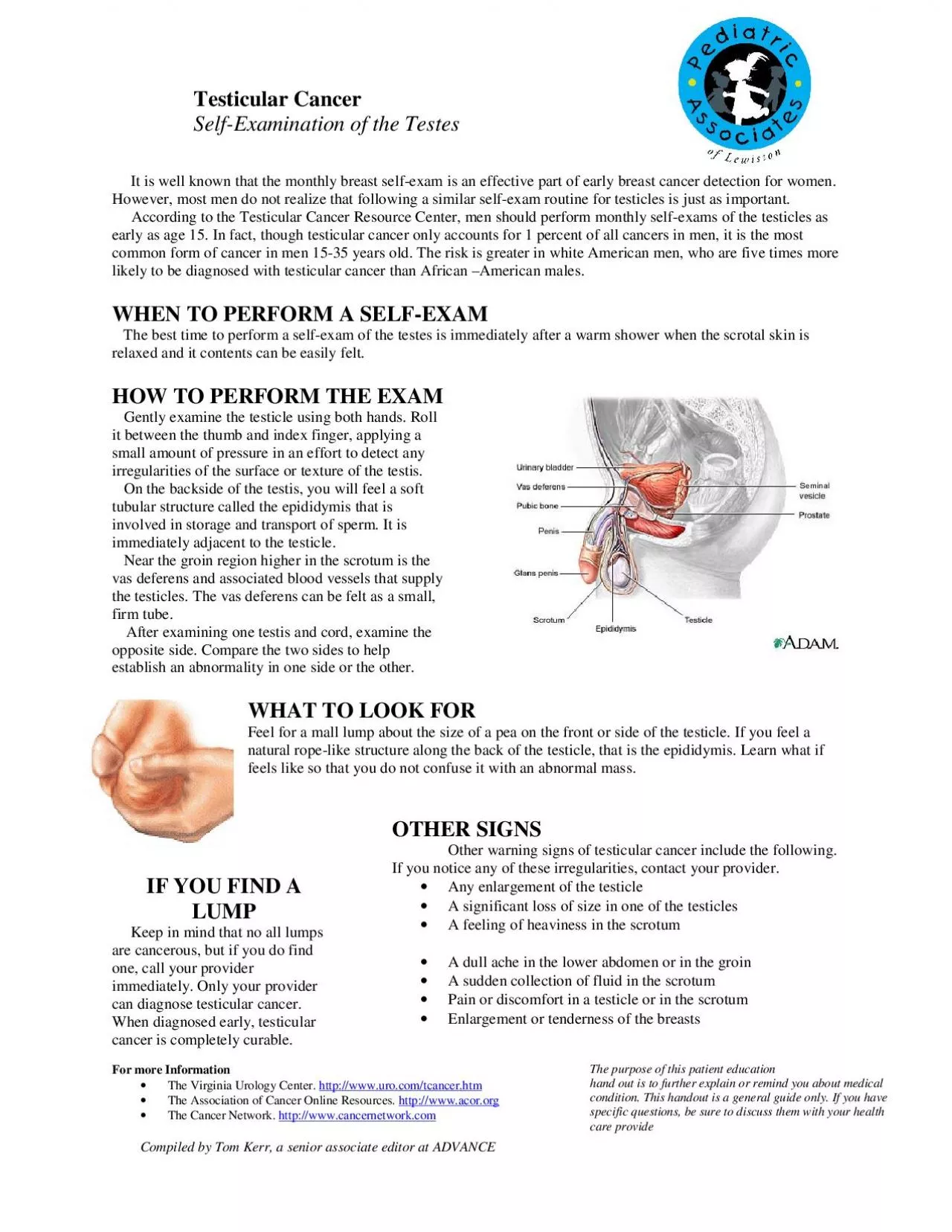

WHAT TO LOOK FOR Feel for a mall lump about the size of a pea on the front or side of the testicle If you feel a natural ropelike structure along the back of the testicle that is the epididymis L ID: 938941
Download Pdf The PPT/PDF document "Testicular Cancer SelfExa..." is the property of its rightful owner. Permission is granted to download and print the materials on this web site for personal, non-commercial use only, and to display it on your personal computer provided you do not modify the materials and that you retain all copyright notices contained in the materials. By downloading content from our website, you accept the terms of this agreement.
Testicular Cancer Self-Examination of the Testes It is well known that the monthly breast self-exam is an effective part of early breast cancer detection for women. However, most men do not realize that following a similar self-exam routine for testicles is just as important. According to the Testicular Cancer Resource Center, men should perform monthly self-exams of the testicles as early as age 15. In fact, though testicular cancer only accounts for 1 percent of all cancers in men, it is the most common form of cancer in men 15-35 years old. The risk is greater in white American men, who are five times more likely to be diagnosed with testicular cancer than African American males. WHEN TO PERFORM A SELF-EXAM The best time to perform a self-exam of the testes is immediately after a warm shower when the scrotal skin is relaxed and it contents can be easily felt. HOW TO PERFORM THE EXAM Gently examine the testicle using both hands. Roll it between the thumb and index finger, applying a small amount of pressure in an effort to detect any irregularities of the surface or texture of the testis. On the backside of the testis, you will feel a soft tubular structure called the epididymis that is involved in storage and transport of sperm. It is immediately adjacent to the testicle. Near the groin region higher in the scrotum is the vas deferens and associated blood vessels that supply the testicles. The vas deferens can be felt as a small, firm tube. After examining one testis and cord, examine the opposite side. Compare the two sides to help establish an abnormality in one side or the other. WHAT TO LOOK FOR Feel for a mall lump about the size of a pea on the front or side of the testicle. If you feel a natural rope-like structure along the back of the testicle, that is the epididymis. Learn what if feels like so that you do not confuse it with an abnormal mass. IF YOU FIND A LUMP Keep in mind that no all lumps are cancerous, but if you do find one, call your provider immediately. Only your provider can diagnose testicular cancer. When diagnosed early, testicular cancer is completely curable. OTHER SIGNS Other warning signs of testicular cancer include the following. If you notice any of these irregularities, contact your provider. Any enlargement of the testicle A significant loss of size in one of the testicles A feeling of heaviness in the scrotum A dull ache in the lower abdomen or in the groin A sudden collection of fluid in the scrotum Pain or discomfort in a testicle or in the scrotum Enlargement or tenderness of the breasts For more Information The Virginia Urology Center. http://www.uro.com/tcancer.htm The Association of Cancer Online Resources. http://www.acor.org The Cancer Network. http://www.cancernetwork.com Compiled by Tom Kerr, a senior associate editor at ADVANCE The purpose of this patient education hand out is to further explain or remind you about medical condition. This handout is a general guide only. If you have specific questions, be sure to discuss them with your health care provide